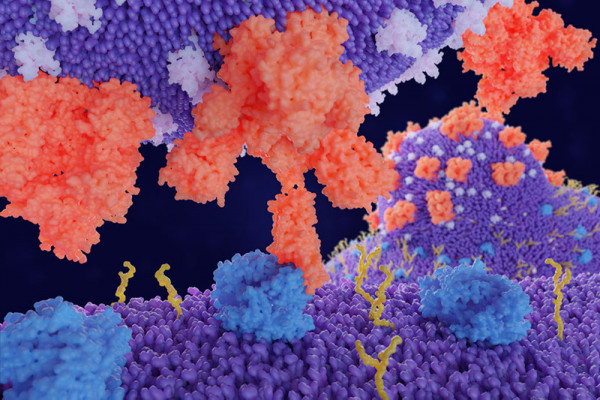The SARS-Coronavirus (SARS-CoV), first discovered 18 years ago, leads to respiratory diseases in infected people.1 To date there are no effective vaccines against any type of the coronavirus, which can cause pneumonia and possibly bronchitis.2 It was found that bats are the natural host of SARSr-CoV (SARS-related coronaviruses).
ACE2 (angiotensin-converting enzyme-2) was previously reported to be the receptor for SARS-CoV and is highly concentrated in airway epithelial cells. SARS-CoV shares 79.5% sequence identity with the novel coronavirus SARS-CoV-2 that causes COVID-19. Based on structural analysis, Wan et al., and Xu et al., found that ACE2 could indeed also be the receptor for SARS-CoV-2.3,4
The first promising data about this topic was published in Nature on Febuary 3rd 2020. Zhou et al., conducted virus infectivity studies and confirmed that ACE2 is required for entry of SARS-CoV-2 into HeLa cells and bats5 (Figure 1). Interestingly the virus could not use the ACE2 receptor to infect mouse cells. The researchers also showed that the SARS-CoV-2 does not use other coronavirus receptors like the aminopeptidase N and dipeptidyl peptidase.5

Figure 1: Fluorescence image of the SARS-CoV-2 receptor usage. Infection of HeLa Cells with or without the expression of ACE2 receptor. h = human. b = bat. Adapted from: Zhou et al., 2020. This image is used under the creative commons attribution 4.0 license.
SARS-Cov-2 Cell Entry Is Blocked by Camostat Mesylate
In a paper published in Cell on March 5th 2020, Hoffmann M. et al. describe how the virus uses the viral spike (S) protein to enter the host cell via ACE2 binding6. They show that host cell entry of SARS-CoV-2 depends on a process called S protein priming, which is carried out by cellular proteases such as serine protease TMPRSS2. This crucial step leads to fusion of viral and cellular membranes. Hoffmann M. et al. also found that TMPRSS2 activity is essential for viral spread and inhibition of TMPRSS2 with the protease inhibitor camostat mesylate can block infection of lung cells. With no vaccination at hand, further understanding of SARS-CoV-2-ACE2 interactions can offer treatment options and lead to anti-infective strategies such as the development of neutralizing antibodies.
 Figure 2: The viral spike protein of the new coronavirus SARS-CoV-2 uses the same cellular receptor (ACE2) as SARS-CoV and requires the cellular protease TMPRSS2 for its activation. Figure: Markus Hoffmann / German Primate Centre.
Figure 2: The viral spike protein of the new coronavirus SARS-CoV-2 uses the same cellular receptor (ACE2) as SARS-CoV and requires the cellular protease TMPRSS2 for its activation. Figure: Markus Hoffmann / German Primate Centre.
ACE2 Antibodies & ELISA Kits
Anti-ACE2 (human), mAb (blocking) (AC384) (preservative free)
AdipoGen Life Sciences produces a unique monoclonal ACE2 blocking antibody.

- Item number: AG-20A-0037PF-C100
- Antibody type: Monoclonal
- Reactivity: Human
- Host: Mouse
- Application: ELISA, WB, FA
Anti-ACE2 (human) Antibody, clone AC18F
AdipoGen Life Sciences produces a monoclonal ACE2 antibody that is suitable for the use in flow cytometry.

- Item number: AG-20A-0032-C050
- Antibody type: Monoclonal
- Reactivity: Human
- Host: Mouse
- Application: FC, ELISA, WB
Anti-ACE2 Antibody
Arigo Biolaboratories offers an IP-grade Anti-ACE2 antibody that is excellent for studying SARS-CoV-2-ACE2 interactions and viral infections.

- Item number: ARG41099.100
- Antibody type: Polyclonal
- Reactivity: Human, Mouse, Rat
- Host: Rabbit
- Application: IHC-P, IP, WB
Human ACE2 ELISA Kit

- Item number: ARG80959.96
- Sensitivity: 12.5 pg/ml
- Sample: Serum, plasma, lysate, cell culture supernatant
- Range: 62.5 to 4000 pg/ml
References
- Smith and Richard D. (2006) Responding to global infectious disease outbreaks: Lessons from SARS on the role of risk perception, communication and management, Social Science & Medicine. 63, 3113–23.
- Forgie S. and Marrie T.J. (2009) Healthcare-associated atypical pneumonia Seminars in Respiratory and Critical Care Medicine. 30, 67-85
- Wan et al., (2020) Receptor recognition by novel coronavirus from Wuhan: An analysis based on decade-long structural studies of SARS. Journal of Virology.
- Xu et al., (2020) Evolution of the novel coronavirus from the ongoing Wuhan outbreak and modeling of its spike protein for risk of human transmission. SCIENCE CHINA Life Sciences 63.
- Zhou et al., (2020) A Oneumonia Outbreak Associated With a New Coronavirus of Probable Bat Origin, Nature Article
- Hoffmann M. et al., (2020) SARS-CoV-2 cell entry depends on A 1 CE2 and TMPRSS2 and is blocked by a 2 clinically-proven protease inhibitor. Cell












